Tribal Chairman – John “Rocky” Barrett
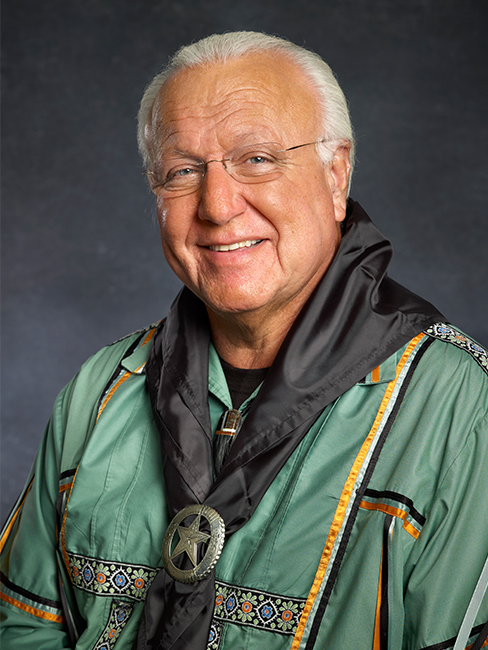
Bozho nikan
(Hello friend),
It is a new year and with it comes another election cycle at Citizen Potawatomi Nation. The 2023 ballot includes the legislative seats for Districts 10, 11 and 13, currently occupied by David Barrett, Andrew Walters and Bobbie Bowden, respectively. They represent all Tribal members living in Oklahoma.
On Dec. 14, 2022, the legislature held a meeting to discuss campaign finance and voted to update the Citizen Potawatomi Nation Election Code. That section of the Nation’s legal framework had not been added to or amended since it was first published in the mid-1980s. We have seen many changes in our world in the last four decades, and as a sovereign government, our election code needs to account for it.
Undoubtedly, the most drastic change is the advent of the internet and access to it through the smartphone in your pocket. Campaigns pay to reach people through their social media accounts, email and text messages, as I’m sure you can attest to during the last election cycle.
The ordinance approved during the Dec. 14th legislative meeting address these issues. The section titled “Definitions for Campaign Finance, Election Material and Reporting” outlines the terms “Ballot Question,” “Campaign,” “Campaign Contribution,” “Campaign Expenditure,” “Candidate,” “Disclosure Report,” “Officeholder” and “Political Organization,” which were previously undefined.
A “Campaign Contribution” refers to “a contribution in money or services to a Candidate or Campaign that is offered or given with the intent that it be used in connection with a Campaign. Whether a contribution is made before, during, or after an election does not affect its status as a Campaign Contribution.”
Gifts and donations or cash loans/equivalents all qualify as contributions as do in-kind gifts, donations, and goods and service loans. This includes expenditures for communications (digital or otherwise) in support of or against a candidate or ballot question. However, uncompensated volunteers and their time are not included.
The section “Public Disclosure of Campaign Contributions” has also been amended. It now states contributions may only be made by individuals (not corporations, partnerships or organizations) and only by members of the Citizen Potawatomi Nation at a maximum of $5,000 per person to any one candidate during an election cycle. Minors cannot make contributions, and contributions cannot be made on behalf of someone else. Direct or indirect reimbursements and anonymous contributions are forbidden. Candidates cannot solicit campaign contributions from CPN employees.
While campaigning, candidates are required to provide monthly financial disclosure reports to the Election Committee as well as a final report, both of which catalog the details of all Campaign Contributions and Expenditures. This includes the name and contact information for each individual making a contribution. Noncompliance can result in disqualification from the election. Approved financial disclosure reports are required before the CPN District Court certifies candidates to take office.
These rules are important, and they ensure the sovereignty of our Nation and its ability
to run fair elections, free of outside influence and spending. Those planning to run for office and everyone supporting or contributing to their campaign should be familiar with the new code. I encourage all CPN members to read the full text of the election code in this edition of the Hownikan.
As always, it is an honor to serve as your Tribal Chairman.
Migwetch
(Thank you),
John “Rocky” Barrett
Keweoge
(He Leads Them Home)
Tribal Chairman
Vice-Chairman – Linda Capps
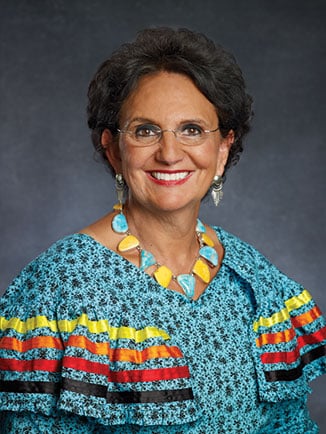
Bozho
(Hello),
By the time this edition of the Hownikan reaches our readers, the new year will be in progress. I hope you had a great beginning and wish you and your family the very best in 2023.
Our Tribe has high expectations for the year. We are well into the planning of the funds allocated from the American Rescue Plan Act (ARPA), signed into law by President Biden on March 11, 2021, which invests $1.75 billion in American Indian and Alaska Native government programs administered under the oversight of the Department of the Interior’s Assistant Secretary of Indian Affairs. These are the funds from which our Tribe sent all members that had been born prior to Feb. 1, 2021, a check in the amount of $1,400. This was the final payment sent out to our members. If you have not applied for this payment, it is still open for disbursement. You can call 405-878-3854. You can also go to portal.potawatomi.org, then go to ARPA. Our records are extremely accurate so please do not file if you have already received payment. If you have filed and have not received payment, you can call the number listed above.
The American Rescue Plan makes changes to laws and provides emergency supplemental funding to respond to the ongoing coronavirus pandemic. Both the CARES funds and ARPA funds helped thousands of tribal members from all federally recognized tribes across America with the pandemic. ARPA funds are still available to tribes to help them recover from the pandemic and help tribes build for future economic development. Every Wednesday, CPN holds a meeting of the executive committee — Chairman, Vice-Chairman and Secretary-Treasurer — plus CPN CFO, attorney, construction director and director of executive operations. These meetings are to plan for growth and expansion utilizing ARPA and Tribal funds. There will be various reports in 2023 to our legislators about the progress of ARPA spending, but progress has already been made in mapping out construction, construction contractor selection, purchasing land and identifying projects that are eligible for ARPA funding.
I am proud to say that the plans for the columbarium have been finalized and construction will begin in the next few months. The construction of the structure suffered delay last year because of the change in materials. Keep in mind that this structure must be built to last for years and must be maintained to last more than 100 years. The dirt work is now in progress on the grounds of the Mission Church, just north of CPN East Clinic. We have received several callsabout the columbarium and who will be eligible for their ashes to be interred in the structure. Each Tribal member and their spouse will be eligible for interment; plus, depending on urn size, there may be room for other family members. The first structure will contain 400 compartments. We are allowing space at the church grounds for additional structures in the long-term future.
I want the Chairman to have the privilege to announce the exact building plans. Please know that the progress of the meetings on Wednesday of each week have been very productive. Brad Peltier is the CPN Director of Executive Operations. He and his team oversee distribution of ARPA funds and has done an excellent job. All in all, I believe 2023 is going to be a good year for CPN. I’m hoping for bright and shiny days for all our Potawatomi Tribal members and their families.
As always, I cherish the opportunity to be your Vice-Chairman of this great, progressive Tribal nation.
Migwetch
(Thank you)
My best,
Linda Capps
Segenakwe
(Black Bird Woman)
Vice-Chairman
405-275-3121 work
405-650-1238 cell
lcapps@potawatomi.org
District 2 – Eva Marie Carney
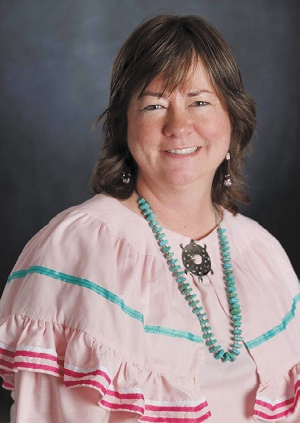
Bozho nikanek
(Hello friends),
New Year greetings and virtual gift
Best wishes for this new year. I wish you and your families peace and good health in 2023. As a virtual New Year gift, I am sharing a link to the music video Speak Again (cpn.news/speakagain). Directed by Nicole Emmons and coproduced by Elexa Dawson (fellow Citizen Potawatomi), the stop-motion-animated musical short is already receiving high acclaim — e.g., it was selected to premiere at LA Skins, Hollywood’s Indigenous Film Festival, late last year. The setting is a timeless Great Lakes shoreline forest, where a Neshnabe (Potawatomi) person situates themselves as a good descendant and ancestor, giving ceremonial offerings to their elder and child, and receiving the gift of language. As the producers describe their work: “The puppetry and collage offer vivid representations of cultural elements, while the music inspires attention and passion for a ‘language near erased.’” The song was co-written by Elexa and the Hon. Jack Markell (former Governor of Delaware), inspired by fellow Citizen Potawatomi Robin Wall Kimmerer’s account of Potawatomi language preservation in her best-selling book, Braiding Sweetgrass. I think it is amazing, and with Nicole and Elexa’s permission, I am featuring it here so that you can watch it too.
Loss of Jim Thunder
For those who missed the news, Jim Thunder, Forest County Potawatomi leader and one of our last Potawatomi first language speakers, walked on in early December. This is a huge loss for the Potawatomi people. You can read Jim’s obituary to learn about his life and varied accomplishments at cpn.news/Thunder. You can leave messages of condolences at the same link.
As our Language Director Justin Neely put it recently, “Jim’s passing will be felt far and wide. He was a great man who spent his life trying to share our language and culture. Migwetch jak she gego ga zhechkeyen bemwedekben. He touched the lives of thousands. He will be deeply missed.”
Some of Jim’s Potawatomi stories told from his memories are captured in Bodwéwadmimwen and English in books published by the nonprofit Bodwéwadmimwen Ėthë ték, the mission of which is to preserve and facilitate the use of the Potawatomi language. Bodwéwadmimwen Ėthë ték translates to The Center for the Potawatomi Language. Learn more about the center and order the books, if you are interested, at cpn.news/bodwe.
February 11 meeting in Montgomery, Alabama
On February 11, I am hopeful that we will have a good turnout for lunch, starting at noon Central Time, followed by a tour of the museum and monument at The Legacy Museum and The National Memorial for Peace and Justice, in Montgomery, Alabama. All details for the meet-up are in the printed invitation, which is also being mailed out to households within driving distance of the event. Please know that you don’t need to receive a postcard to attend — just email or call me to let me know you will be attending.
Please keep in touch I look forward to hearing from you and to seeing many of you
in person in this new year! Migwetch (thank you) for the honor of representing you.
Bama mine
(Later),
Eva Marie Carney
Ojindiskwe (Bluebird Woman)
she/her/hers
Legislator, District 2
5877 Washington Boulevard
P.O. Box 5591
Arlington, VA 22205
888-849-1484 toll-free
evamariecarney@gmail.com
evamariecarney.com
District 3 – Bob Whistler
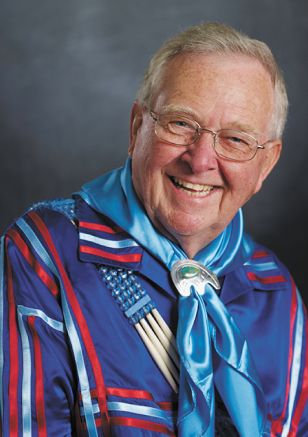
Bozho nikan
(Hello friend),
As mentioned in my December article, I was asked to close the District 3 Tribal office by the firm we leased from. I relocated to my home and will use that for now. I will get a P.O. Box for any needed mail. In the meantime, if you need to reach me just send me an email to rwhistler@potawatomi.org.
Hand language
Let me cover two subjects briefly in this topic. Prior to the arrival of the Europeans and
for a short period thereafter, the use of hand language was common between the plains
tribes who did not speak one another’s language.
Some of the common Native American hand signs they used were: closed fist of right hand facing out but resting on forehead was used to designate they were talking about the Crow Nation. For your age, first indicate the number of years, then make the sign for winter. For “winter,” hold both fists in front of your chest, with the backs of the hands facing the person you are speaking too. Then shake the hands to symbolize the fall of snowflakes. Affection was indicated by making two fists and place them across your chest like an X. The sign for a baby was to place the right hand clenched against the left side of the chest, palms inwards. Clasp the right forearm with the left hand as if holding a baby.
I brought up their hand sign for baby since that is my second area. I recently saw a brief clip on a mother who taught her baby to use sign language. She indicated that regardless of the age of the baby, once they can sit up and use their hands, they can communicate with you actively. For example, if they want milk, say the word “milk,” then clench both hands and pull down. This is similar to how cows were milked by hand.
After seeing this clip, I went online and found that there are very inexpensive books available to buy to help you teach a baby hand language. For any of you who have babies of your own or have grandbabies, you might consider getting one of these books. It would certainly make things clear between you and an infant in need. Walmart has Baby Sign Language Basics book for about $5. Amazon has My First Book of Baby Signs: 40 Essential Signs to Learn and Practice at $7.99. Simply go online and type in “shop baby hand language.” A final note: when showing the sign and giving the item, you need to say the word for them to learn.
In 2022, I was able to hold meetings in the Dallas area and in Corpus Christi. In 2023, I
will try to get one centralized to the area that would cover Houston, San Antonio and Austin. Here in the north, I may try to get with Gene Lambert of District 5 and host a joint meeting in a city that is in a border city for us. Most likely it will be physically in District 5. More on this next month.
In closing, I am honored to serve as the District 3 legislator and am here to assist you on any questions about services the Nation provides. Simply give me a call or send me an email.
Bama pi
(Later),
Bob Whistler
Bmashi (He Soars)
Legislator, District 3
112 Bedford Road, Suite 116
Bedford, TX 76022
817-229-6271 cell
rwhistler@potawatomi.org
cpn3legislator@yahoo.com
bobwhistler.com
District 4 – Jon Boursaw
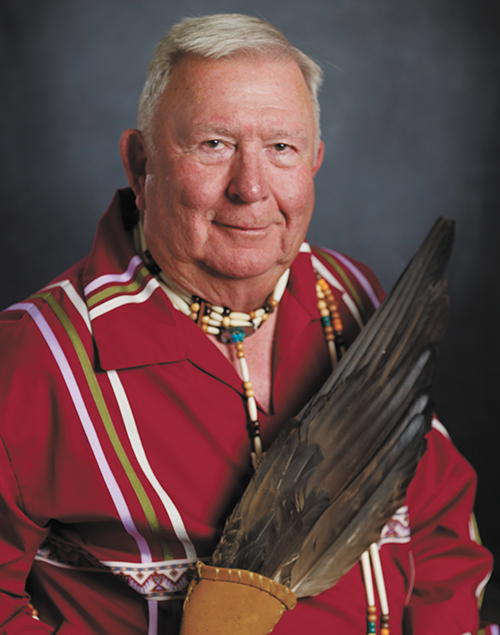
Bozho
(Hello),
A New Year ahead
First, Peggy and I hope each of you had a joyful and safe holiday season, and we want to wish everyone a very Happy New Year. I’m looking forward to 2023 as a year of accomplishments and continued growth for the Nation.
November 2022
I look back on November 2022 as quite a month for me. I was involved in two events that allowed me to represent the Nation with pride, while offering me the opportunity to participate in two once-in-a-lifetime events.
First was the opportunity to attend the dedication of the Native American Veterans Memorial located at the National Museum of the American Indian in Washington, D.C., on Veterans Day, November 11th. I was fortunate to be one of three CPN Legislators selected to attend the event. The event was attended by close to 2,000 Native American veterans representing tribes from across the country. While there, I had the opportunity to reconnect with Harvey Pratt, a Cheyenne and Arapaho veteran from Oklahoma, who was a designer of the memorial. I first met Harvey 14 years ago when I was the director of the CPN Cultural Heritage Center. I also had a brief conversation with Wes Studi, the Native American actor and a Cherokee veteran from Oklahoma, while both of us were touring the memorial. Both Harvey and Wes are Vietnam War veterans.
The second event was when I was asked to represent Chairman Barrett at the Kansas
City Chiefs football game when they recognized two members of their team who are Native American, one of whom is Creed Humphrey, a CPN member from Shawnee, Oklahoma. Creed is the Chiefs’ center and is considered one of the best in the National Football League. It was my pleasure to meet several members of the team’s management staff including Chief Executive Officer Clark Hunt. I was allowed to bring a guest, so I used this opportunity to share the experience with my son, Drew, who is a high school teacher in Maine. What a great weekend!
Upcoming CPN Elders’ Potlucks
The dates for the next two Elder Potlucks held in the CPN Community Center in Rossville at noon are:
• January 13th (RSVP by the 10th) — Meat loaf
• February 10th (RSVP by the 7th) — Chicken pot pie
Come join us and bring your favorite side dish or dessert. If you plan to attend, please RSVP to Tracy or Brenda at 785-584-6171.
Ongoing Projects
As you may recall, I’m involved, along with other CPN members, in projects to improve the appearance of two of the Nation’s historical sites in the local Topeka area: Abram Burnett’s burial site and the Uniontown Cemetery.
Here is the status of these projects as of early December:
Burnett’s burial site in Topeka: My cousin Joe Wulfkhule, his grandson, Anthony, and I have removed the old chain link fence that surrounded the grave and two trees, which encroached on the site. We still need to remove the fence posts and the tree stumps. Once those tasks are completed, we can have the new black wrought-iron fencing installed, clean up the grave monument and work on landscaping the site. From here on, it all depends on the availability of good weather allowing us to finish this project.
Uniontown Cemetery near the small community of Willard: This cemetery is located across the Kansas River from Rossville on the western Shawnee County line. We have deferred any further work on the site until we have secured an experienced rock wall builder. We don’t want to start removing the rock wall that is on the site until we have someone on site to instruct us on rebuilding it. Basically, this involves a solicitation of bids for costs as well as a description of how the work will be done. We have an individual familiar with this type of project, who is not a Tribal member, working with us. He will assist us in evaluating the bid proposals. We have received a small federal grant that should cover the costs of the project. We anticipate starting this project no later than mid-March.
Migwetch
(Thank you),
Jon Boursaw,
Wetase Mkoh (Brave Bear)
Representative, District 4
2007 SW Gage Blvd.
Topeka, KS 66604
785-861-7272 office
785-608-1982 cell
jon.boursaw@potawatomi.org
Office hours:
9-11 a.m. Tuesdays
3-5 p.m. Thursdays
Other times: please call
District 5 – Gene Lambert
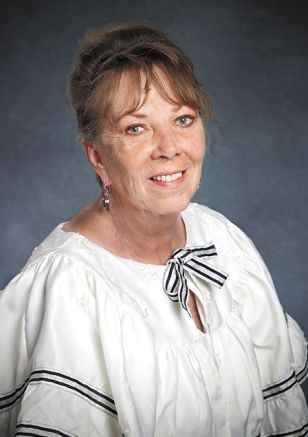
Bozho
(Hello),
Happy January 2023” is for everyone. I was going to say, “Happy New Year.”
However, after having an enjoyable conversation with Justin Neely, director of the CPN Language Department, I find that can mean many different things to people depending on the world they live in.
For instance, January 1 really did not mean the beginning of a new year for our ancestors of Citizen Potawatomi Nation.
One can think of the new year as “new” or the beginning of something other than a calendar date. We do not always consider what that might have been in generations past. For our ancestors, it was the springtime or planting season as they had just survived a frigid winter, which would be January.
“Let’s go find the wood to stay warm” would not have as much comfort nor the beginning of anything as we identify. This is survival and a celebration in spring that we survived another cold season as many others did not.
It would be easy to see why the “New Year” would be spring when everything wakes after hibernating from a chilling winter.
The reality of “new” would be better recognized as the tiny leaves began to sprout from the trees or a small plant peeking from under the earth’s brown weathered coat. The reserve supplies were gone, and now they see a bright new future budding in front of them.
I have not had to cope with the cold for survival. I have had to learn to guard from the
extreme heat here in Arizona. These temperatures can reach as high as 120 degrees, destroying any plant life. Undoubtably, the Arizona Natives had opposite survival issues.
In today’s world, we turn on the air conditioning or heater. A life with little or no interruption regardless of what is happening outside our homes, cars, restaurants, etc. A luxury our ancestors did not have nor even dream.
Whatever that means in your life, nonetheless, a new season is upon us.
Yours might be a new level of education, another child on the way, a consciousness or wedding is in your “new year” or transformation.
This sounds increasingly more like the article I wrote on Kokopelli a couple of years back. From the explanation, Kokopelli was the new beginnings of life.
It is my prayer that whatever your “new” is comes in abundance.
Let 2023 be a year of love, health, wealth, tolerance, sharing, giving and, above all, peace.
Stay in touch and let me know what I can do to be of assistance.
Love you all,
Eunice Imogene Lambert
Butterfly Woman
Legislator, District 5
270 E Hunt Highway, Ste 229
San Tan Valley, AZ 85143
480-668-0509 office
480-228-6569 cell
euniceilambert@gmail.com
glambert@potawatomi.org
District 9 – Paul Wesselhöft
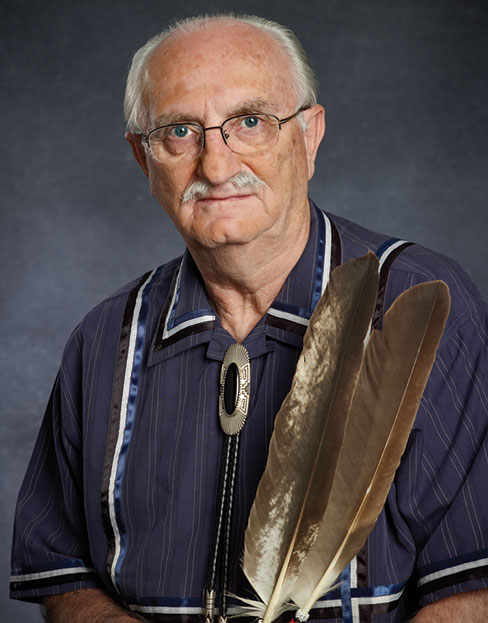
Bozho nikan
(Hello friend),
Native American veterans Native Americans, more than any other ethnic group, have served and continue to serve in the United States military. Why? Native Americans have served more than other groups in a governmental organization that has killed more Indians in a de facto genocidal policy. Why? I will return to this question later.
As a legislator and veteran, I was honored to represent the Citizen Potawatomi Nation, along with Legislators David Barrett and Jon Boursaw, at the dedication of the National Native American Veterans Memorial at the National Museum of the American Indian in Washington, D.C.
While I was in the U.S. Capitol, I paid honor at the World War II and Vietnam War memorials. I lost several of my high school friends in Vietnam. In years past, I gave honor at the Korean War Veterans Memorial as well. Soon there will be a memorial dedicated to the Persian Gulf War veterans. I hope to return to honor my fellow veterans there.
I volunteered to serve in the Vietnam era as a Private, Specialist and Sergeant. Later,
I served as a Chaplain in the ranks of Lieutenant and Captain, and I retired as a Major serving a 20-year career. I served in the Airborne First Ranger Battalion, 75th Infantry, and I served in combat in the first Persian Gulf War: Desert Shield and Desert Storm.
At the dedication, I have never been around so many Native Americans, thousands, from all over the nation. I also meet numerous Potawatomi from other bands. It was a special experience, marching in a long parade through the streets of our Capitol. I can’t imagine another opportunity when I will be with that number of Indians again. It was a wonderful experience!
Now back to why Native Americans serve more than any group in the United States
military. I propose three reasons:
First, many serve in the military because the military provides a good and reliable income. There is nothing wrong with men and women joining the military for financial reasons. The military also offers good training and prosperous careers.
Second, many Native Americans serve in the military because of their warrior spirit. Historically, Indians have been strong fighters protecting their families and defending their ancestral lands, which they consider mother earth. Combat is in their DNA.
Third, many Native Americans serve in the military because they are patriotic, and they
believe it is their duty to serve and defend their nation, which has given birth to them.
They are honored to be dual citizens, and they care for and love the United States despite America’s historical sins.
There may be other reasons why Indians serve the military more than any other group. I’m open to learn more about this subject and invite readers’ opinions.
I am proud to be a combat veteran, and I salute all of you who have served in military uniform as well as the spouses who supported them. I especially honor those Native Americans who gave their last breath defending both of their nations.
Migwetch
(Thank you),
Paul Wesselhöft
Naganit (Leader)
Legislator, District 9
reppaul@gmail.com
pwesselhoft@potawatomi.org
District 10 – David Barrett
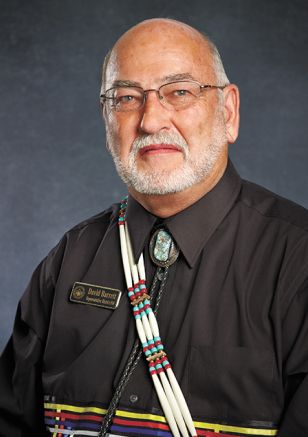
Bozho
(Hello),
The National Native American Veterans Memorial dedication took place in Washington, D.C. on Veterans Day, Nov. 11, 2022. Paul Wesselhöft, Jon Boursaw and I had the privilege of joining the museum in honoring the exceptional military service of Native Americans at the event. The dedication and processional honored American Indian, Alaska Native and Native Hawaiian veterans and their families.
In 1994, Congress passed legislation establishing the memorial. Out of 120 submissions, they chose Harvey Pratt, a Cheyenne and Arapaho who served as a Marine in Vietnam, to design it. The memorial’s groundbreaking took place on Sept. 21, 2019, which I also attended. Native American leaders said that before the memorial opened, Indigenous veterans had to go to the other war memorials in D.C. on the National Mall for tributes. Getting a memorial to recognize Indigenous peoples’ service near the National Museum of the American Indian was a long time in coming.
Native veterans were invited to participate in the procession along the National Mall from the museum to the ceremony stage in front of the U.S. Capitol. It was raining, but this was nothing compared to the emotional experience for the people whose ancestors had been forced from their lands and treated harshly. In the procession, veterans rode in motorized wheelchairs, while others used canes or walkers. You had veterans who wore jackets or baseball caps that showed which service they were. Some wore their traditional Indigenous regalia while others were in full military dress as they carried flags of the United States, their military branch and tribal affiliations.
The Native American Veterans Memorial sits on the grounds of the NMAI. Called the Warriors’ Circle of Honor, the memorial stretches 12 feet tall and is a stainless-steel circle that’s balanced on a carved stone drum. The circle represents “the hole in the sky where the Creator lives,” according to Pratt, and visitors often tie cloths for prayers and healing — a Native American tradition — on four lances around the edges of the memorial.
Visitors can also see the exhibition Why we serve: Native Americans in the United States Armed Forces on the museum’s second floor. At least 12,000 Native Americans served during World War I and 44,000 in World War II. In the Korean War, there were 10,000 and about 42,000 that served in Vietnam. Indigenous people have a long history of service in the U.S. military and have served in every major military conflict since the Revolutionary War. Museum experts said that compared with other population groups in the U.S., Indigenous people serve at “extraordinarily high numbers.”
Before we made it to D.C., Paul Wesselhöft and I experienced something that I wasn’t aware of, nor ever heard of. As we were taxiing on the runway to begin our flight to D.C. from the Dallas/Fort Worth airport, we encountered two fire trucks on both sides of the American Airlines aircraft spraying a full stream of water flowing over our plane preparing to take off. Also, as we were looking out our windows, we saw the personnel saluting as the plane made its way forward. We found out later that this was a “water salute” for the body we were carrying to Arlington National Cemetery. When we landed in D.C., all the passengers had to remain in their seats until the captain debarked the aircraft to assist in the escort of the body. This meant that the plane was not carrying a piece of cargo but a precious body that should be shown deep respect.
After doing research, more information was discovered who the body was. According to an August 2022 report from Charlotte, North Carolina, NBC affiliate WCNC, “After decades of searching, the remains of North Carolina native David N. Owens, who served as an Army private during WWII, have been recovered near Hurtgen, Germany.” He died in combat at 27 years old.
You won’t be able to recall everything you have done in the past, but those precious moments in your life, you will be able to recall for a long time. Hope everything is starting off good for you in 2023. Thank a veteran, first responder or a person in blue.
It goes without saying that it is both a pleasure and an honor to serve you and our great Nation.
Migwetch
(Thank you),
David Barrett
Mnedobe (Sits with Spirit)
Legislator, District 10
1601 S. Gordon Cooper Dr.
Shawnee, OK 74801
405-275-3121
dbarrett@potawatomi.org
District 11 – Andrew Walters
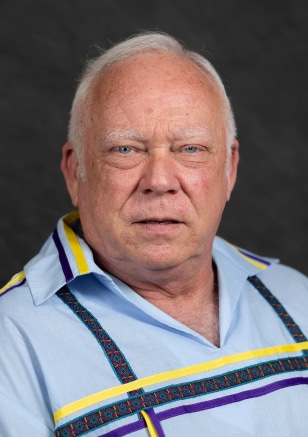
Bozho
(Hello),
Our Tribal government is based on a constitution that was adopted in 2007. This constitution is a framework that supports how our government operates. The articles of both constitutions, the U.S. and Tribal, are directed at controlling governmental actions. Outside of how those constraints to government affect each of us as Tribal members or U.S. citizens, the constitution has no controlling effect on each individual member. Its purpose is to control government in a way to assure that citizens are “governed” and not “ruled.” In a true democracy, each time the chairman purchases a box of paperclips, a chair, a police car, we would all have to vote on the expenditure. In our constitutional republic/representative form of government, Tribal members elect folks that we feel mirror our important values and would be good shepherds of our Tribe, our people. Then, we place them in those positions to make decisions for all of us. Each year, during Family Reunion Festival, we vote for different folks vying for office. Each office, in general, lasts for a period of four years. The expiration of these positions is staggered so that a continuous flow of responsibility is possible without the interruption of new office holders learning their jobs.
Our Tribal government is divided, much as the U.S. government, into three parts — executive, legislative and judicial. The Chairman, Vice-Chairman and Secretary-Treasurer make up the executive branch. Their job, like any corporate officer, is the daily operation and decision making of the Tribe.
The legislature, comprised of five Oklahoma legislators and eight district legislators, is responsible for reviewing and passing new laws, reviewing expenditures and providing representation for members within their districts and within the Tribe as a whole. The Tribal constitution limits the ability of the legislature to speak and act on behalf of the Tribe except by resolution or ordinance, duly voted on by the legislature. The ability to appropriate Tribal funds, create Tribal employment positions or departments, and contract on behalf of the Tribe are powers reserved only to the legislature.
The judicial branch is made up of a series of judicial officials, judges, who have varying
responsibilities within our legal framework from prosecution of crime, settlement of civil
disputes, appeals, Indian Child Welfare matters, divorces and other actions. The Tribal court system is designed to provide for the enforcement of Tribal laws, equal justice and protection of Tribal sovereignty. We have seven Supreme Court justices and three District Court justices.
Although this may seem elementary to some of you, I have come to realize through
interactions with many Tribal members that, in general, members don’t know or understand the place our Tribal government has in our lives. Many think that the Chairman can simply wave his hand and “rule” the Tribe in any manner he pleases. Some think that legislators should “fight” for causes rather than review and debate issues in an open forum. In truth, decisions are based on the representative majority desires, not the loudest voice, trendiest thought or strongest hand. We are not a dancing puppet of the federal government. In truth, we have a vibrant, powerful sovereign government. It is comprised of knowledgeable people who are notable in their fields. And the tenets of our constitution are firmly in line with the finest ideas of liberty and justice held dear by all humans since time began. Together we govern the Tribe in a manner to benefit all. Your participation is vital to those ends. Contact your legislator; talk to your government. We can only do what we think best based on all of your concerns and ideas.
Migwetch
(Thank you),
Andrew Walters
Legislator, District 11
andrew.walters@potawatomi.org
nibwemko@gmail.com
